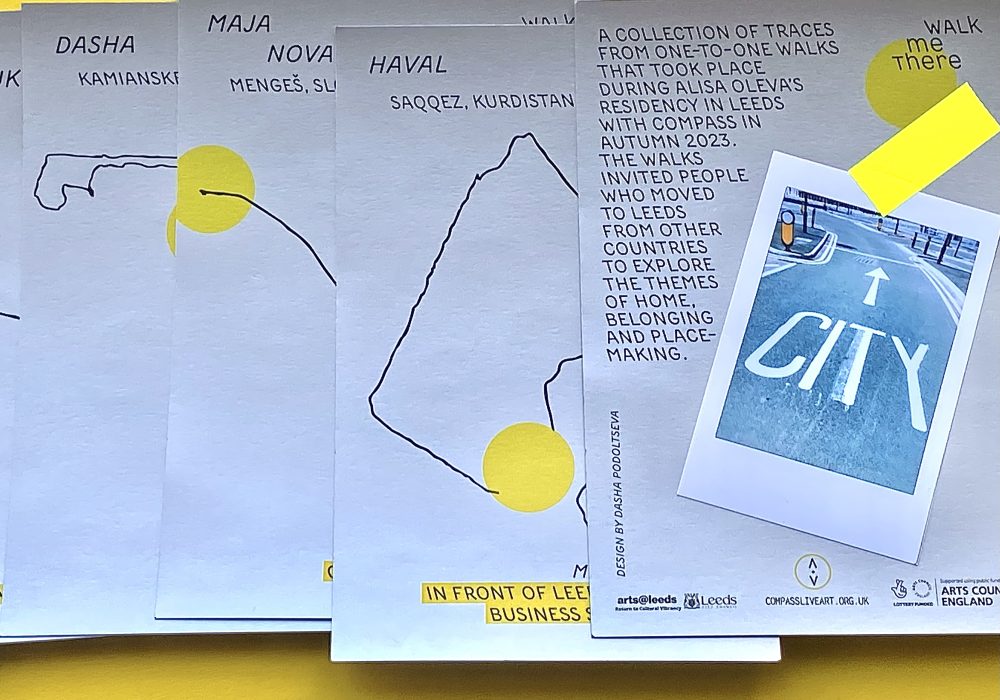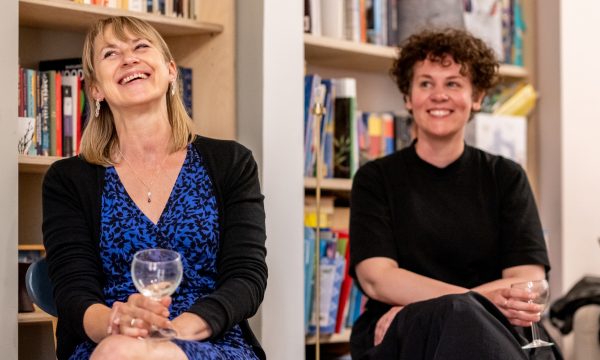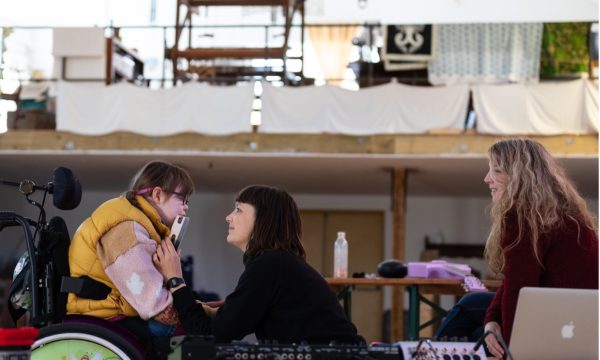Postcards representing the paths of the walks Alisa and her partners went on. Designed and made by Dasha Podoltseva, 2023
Over Alisa’s residency period in August, she went on one-to-one walks, hosted two group “walkshops” and created some beautiful memories with people living in Leeds: Anastasiia Abramchuk, Madda Moretti, Tatiana, Yuma, Haval, Maja Novak, coni, Mishka and Dasha.
Photos by Alisa Oleva, August 2023 on film
On a fresh November afternoon, three months after her residency project finished, I sat down on a Zoom call with artist Alisa Oleva. Despite the darkening of her video as the sun went down outside, and the 170 miles between us, she managed to convey her practice and reflections on her recent project Walk Me There with charm, and created a welcoming environment that I can only imagine was also present during her walks.
Over her residency period in August, Alisa went on one-to-one walks, hosted two group “walkshops” and created some beautiful memories with people living in Leeds.
Alisa developed her artistic practice of walking without realising where it would lead her. She migrated at 17 years old and described her living conditions as poor, living for free, but having to work for it. She wasn’t invited into spaces and places, and as a result she says ‘walking became a place…because of the lack of invitation to occupy places’. Within her own practice of walking, Alisa is focused on always inviting people to join her in her practice so as to remove this feeling of not being invited to occupy a space. She grew up living in the suburbs of her home city and would also go on regular hiking trips, so walking has always been part of her life, she describes it as fluid and a way of escaping the lack of belonging. As a student she used to take buses from the very first stop, all the way to the very last stop, or she’d get up one day and decide to walk north, south, east or west for as long as she could.
Alisa tells me she wanted to create a space and project specifically for those who had migrated from another country to Leeds. There is something about how one engages and builds a relationship to a new culture, language and lifestyle that she wanted to explore. She also tells me she is glad to have made an artistic practice which is financially accessible to people, particularly as those who she often works with are fellow migrants, and so therefore don’t always have the means to be involved in art, but have the desire to. She says she wants to create ‘everything with nothing’ and therefore works using a very small budget, and puts most of her money, if any, towards documenting her projects, and gifting things to her participants.
Despite her familiarity with one-to-one work and with using walking as a practice, Alisa revealed to me that working with this much dialogue and conversation was new to her. She has done projects before where walking is done with blindfolds, mirrors or headphones, but wanted this residency to be more focused on the shared knowledge and experiences of her walking partners, not the performance of it all.
I asked her how she structured each walk and she said she referred to it more as a score than a structure. Due to each walk being with completely different individuals from different contexts and backgrounds, she found the concept of a changeable score worked better. The ephemerality of each walk was something to cherish.
Photos by Alisa Oleva, August 2023 on film
Each walk would begin with her inviting her walking partner to pick a starting point which either reminded them of their hometown, or was a place in Leeds which made them feel at home, and this would be the meeting point, where they would start their walk. They would then walk together for as long as her walking partner wanted to. Alisa says ‘some people just wandered, others had an exact route they wanted to follow.’ Walking in this way would encourage conversation and Alisa made sure that the walk felt casual and not like an interview. The conversations would revolve around ideas of creating new identities in a new place, how you bring your old identity with you or how you build a relationship with a new place and make it your own.
Alisa gave her walking partner an Instanx camera and asked them to take two pictures. She would invite them to keep one of the photos and gift the other one to her. Alisa enjoyed watching what different individuals would decide to take a photo of – some would take the same photo twice so they both had the same memory, others would take photos of Alisa, and others would take photos of the landscapes around them or objects they came across.
Each walk concluded with Alisa gifting her walking partner with a small bag of treats, made up of a bag (inspired by Ursula K. Le Guin’s idea of a bag as a container and holder of stories), a thank you postcard, clay, chocolates and objects with a more personal touch that differed between each participant.
When I asked Alisa for any reflections she had upon completing her residency, she told me if she was to change anything, it would be to do it for a longer period of time. Within her first visit, interest in the walks was slow and steady, but by her next visit only a few weeks later, people were a lot more interested and invested. She would also love the opportunity to make it something that was a more regular and permanent fixture so that people migrating to Leeds from their hometowns would have somewhere they were immediately invited to be.
Of course, I had to ask her what she thought of Leeds, to which she replied ‘I loved the city! And you can tell people I haven’t been paid to say that!’. It seems Leeds made a very lasting impression, as she told me about all the different communities she met, and how she enjoyed the ‘complexity of the city’ and the ‘different patches’ it has to offer. She describes it as much more scalable than London, and her specific inquiry of place-making felt like a very relevant question to ask in a city where people with experience of migration often seem to be less present across different sectors of city life.
Before we ended our conversation I asked Alisa for any words or phrases that encapsulated her experience. She sat for a moment before answering ‘beautiful, intense, nourishing and emotional.’
Walking in itself may be something we do everyday, a time to reflect that we may even take for granted. Next time you go out for a walk around your hometown, be it Leeds or not, I invite you to look around and reflect on the route you’d take Alisa on, she may well come to your city next.
To see more of Alisa’s work, please find her website here.



